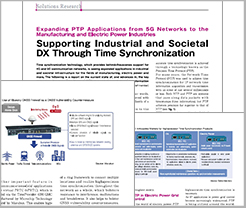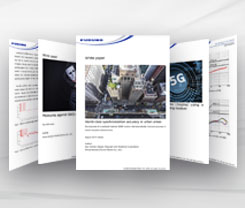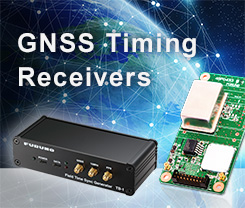Column
How to select GPS/GNSS antennas for time synchronization
When using a product embedded with GPS/GNSS receiver for timing, the GPS/GNSS antenna and peripheral parts must be properly selected and installed.This section explains how to select and install GPS/GNSS antennas for long-term timing solutions without malfunction or troubles.
How to select GPS/GNSS antenna
Select the right GNSS antenna for your GNSS receiver

There are many frequencies broadcasted from satellites depending on the type of constellations and signals. For example, the L1 signal of the GPS constellation is 1.57542 GHz and the L1 signal of the GLONASS constellation is 1.602 GHz. Please check the satellite systems and signal types supported by the GNSS receiver and select a GNSS antenna accordingly.
Select the right antenna according to the environment

Satellite signals are very weak. When installing a GNSS antenna close to other antennas ex. radio system, a noise filter built-in antenna is recommended.
Regarding the shape of the antenna, if the antenna is to be installed in an area with heavy snowfall, special shape to prevent snow from accumulating is recommended.
In addition, GNSS antennas are recommended to be installed in an open sky environment, which is often on rooftops. If lightning surge protection is required, please consider installing a lightning arrester as part of the set.
Notes for GPS/GNSS antenna installation
Cable (coaxial cable) length and distribution

When the distance between the antenna and receiver is long, such as when the GNSS antenna is installed on the roof of a building and the GNSS receiver is installed indoors, signal attenuation must be considered. Please consider adding an amplifier.
Also, when using the signal from one GNSS antenna with multiple GNSS receivers, please use a dedicated splitter.
Antenna setting and waterproofing

It is highly recommended to install the GNSS antenna outdoors with open sky, in order to ensure good reception of signals from GNSS satellite. The antenna should be fixed with a pole or similar structure using a dedicated mounting tool.
Even if the antenna itself is waterproof, the coaxial connector is not, so please use self-bonding tape or other waterproofing treatment.
Reference materials
GNSS Antenna Installation
Using Furuno GNSS antennas as an example, this document explains the mounting bracket required for installation and the installation procedure with photographs.
Downloads (Documentation, Software)
Three essential points when installing a GNSS antenna
When installing a GNSS antenna, components such as the coaxial cables and amplifiers should be selected to satisfy the antenna specifications of the GNSS receiver. It is also necessary to consider the propagation delay between the antenna and the receiver.
In this document, we explain how to calculate the required specification values with concrete examples from the viewpoint of a GNSS receiver manufacturers.
・Total gain
・Total NF
・Propagation delay in coaxial cables
It is especially useful for those who are new to GNSS receivers.
We have prepared an Excel tool for calculating "Total Gain" and "Total NF" due to their complex formulas.
Please fill in the form to download the document and calculation tool.
GNSS Antenna Installation Guide Download Form
How to install a "surge protective device" to enhance lightning surge resistance? (with examples and test results)
There are two types of surge protective devices (SPDs) for GNSS receivers
・Against direct lightning strikes, that is against surges caused by direct ligthning strikes on the antenna.
・Against induced lightning, that is against surges caused by the magnetic field generated by near-by lightning strikes.
By combining the above two types of SPDs, lightning surge resistance is enhanced.
Due to recent abnormal weather conditions, countermeasures against lightning surges are becoming more important. Using our SPD model TVA-03C for direct lightning and model TVA-03V for induced lightning as examples, we will introduce their installation methods and the results of lightning impulse tests.
You can download this document by filling out the form below.
Surge Protective Device Document Download Form
Pick up
Column
FURUNO Column
-
Common Problems That Affect GPS/GNSS Time Synchronization

-
How to select GPS/GNSS antennas for time synchronization

Column by Mr. Mitsunari Kita (Science and technology writer)
-
The Observation Network Created by the Earthquake Proves Useful for Accurate Timekeeping (Part Two of Two) - A Solution to the "Mr. Higgins Problem" in Space -

-
The Observation Network Created by the Earthquake Proves Useful for Accurate Timekeeping (Part One of Two)

-
FURUNO ELECTRIC Joins Experts From Around the World on a Norwegian Island for Jammertest 2024

-
Unraveling the Mysteries of Venus Based on "Occultation"

-
Atoms as the Basis for Measuring Both Fleeting Moments and Near-Eternities

-
Time Progressing with a Speed Difference of Just 4.4647 Ten-Billionths!

-
Critters Who Revitalize Forests Through the Spreading of Food Caches

-
Small But Significant Variances in Gravity and Time (Part Two of Two)

-
Small But Significant Variances in Gravity and Time (Part One of Two)

-
Why the GT-100 Time-synchronization GNSS Receiver Module is Like Fragrant Soup Curry

-
What Rainbows Can Teach Us About Dual-Band GNSS

-
The Amazing Things That Are Possible With Just a Clock

-
When Subterranean Earth Meets Outer Space

-
Using the TB-1 and GT-100 at a "Multipath Dojo" in the Major Metropolis of Osaka

-
The Disaster-struck Field Time Sync Generator TB-1: True Performance Revealed Through a Lightning Strike

-
Knowing the "Now" of Our Earth Through GNSS

-
The Reason GPS Counts Time in 1.5-second Intervals

-
Similarities Between "On My Count!," the 117 Notification System, and GPS

-
Reliable Clocks Help Us Find a Silver of the Clouds

-
Why Time Synchronization is Vital for Criminal Investigations, Seismograph Measurements and Solar Wind Observation

-
What Was "Cesium" About Cesium Akina?

-
Updating Analog Broadcasting with GNSS Time Synchronization Technology

-
The Long History of One Second (Part II)

-
The Long History of One Second (Part I)

-
A Solo Journey - Three-liter Microsatellite Mission Support via GPS (GNSS) and Satellite Communication -

-
A Solo Journey - The GPS (GNSS) Tracking System That Helped Kenichi Horie Cross the Pacific -

-
The Day After a Superflare - Effects on power and wireless communication infrastructures -





